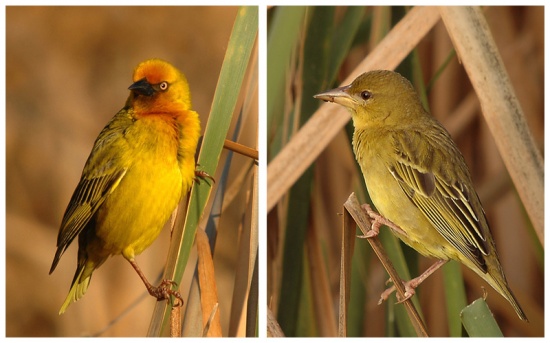m |
(text added) |
||
| Line 3: | Line 3: | ||
==Other Names== | ==Other Names== | ||
Deutsch: Kapweber; Afrikaans: Kaapse Wewer | Deutsch: Kapweber; Afrikaans: Kaapse Wewer | ||
| − | == | + | ==Identification== |
| − | 17 - 18 cm | + | Length 17-18 cm, mass 36-55 g; males larger than females. The Cape Weaver is a stocky bird with streaked olive-brown upper parts and a long pointed conical bill. '''Adult breeding male''': Face and chin chestnut- to orange-brown; gradual transition to yellow on the rest of the head. Wings olive-brown, feathers edged yellow. Underparts yellow; some birds have chestnut-brown or orange feathers on the breast and belly. The iris is white and the bill is black. '''Adult non-breeding male''': Duller than the breeding male, with a brown bill, and often without the dark face. '''Adult female''': Dull olive-brown above; wings brown with feathers edged yellow. The chin and throat are pale yellow-buff, shading to pale yellow on the lower belly. The bill is light brown, and the eyes are brown. '''Immature''': Similar to the female, but greener above. |
| + | ==Distribution== | ||
| + | [[South Africa]], [[Lesotho]] and [[Swaziland]]. | ||
| + | ==Taxonomy== | ||
| + | Some authors recognise three subspecies, but these are poorly defined: there is considerable variation within flocks and regional variation is largely clinal. | ||
==Habitat== | ==Habitat== | ||
| − | This common species occurs in grassland, agricultural and fynbos habitats, often near rivers. | + | This common species occurs in grassland, agricultural and fynbos habitats, often near rivers. Frequently roosts and breeds in reedbeds. |
==Diet== | ==Diet== | ||
The Cape Weaver forages on ground, turning over small stones and dried animal-pats or perches on vegetation. He feeds on a wide variety of seeds, grain and insects. | The Cape Weaver forages on ground, turning over small stones and dried animal-pats or perches on vegetation. He feeds on a wide variety of seeds, grain and insects. | ||
Revision as of 06:15, 3 December 2007
- Ploceus capensis
Other Names
Deutsch: Kapweber; Afrikaans: Kaapse Wewer
Identification
Length 17-18 cm, mass 36-55 g; males larger than females. The Cape Weaver is a stocky bird with streaked olive-brown upper parts and a long pointed conical bill. Adult breeding male: Face and chin chestnut- to orange-brown; gradual transition to yellow on the rest of the head. Wings olive-brown, feathers edged yellow. Underparts yellow; some birds have chestnut-brown or orange feathers on the breast and belly. The iris is white and the bill is black. Adult non-breeding male: Duller than the breeding male, with a brown bill, and often without the dark face. Adult female: Dull olive-brown above; wings brown with feathers edged yellow. The chin and throat are pale yellow-buff, shading to pale yellow on the lower belly. The bill is light brown, and the eyes are brown. Immature: Similar to the female, but greener above.
Distribution
South Africa, Lesotho and Swaziland.
Taxonomy
Some authors recognise three subspecies, but these are poorly defined: there is considerable variation within flocks and regional variation is largely clinal.
Habitat
This common species occurs in grassland, agricultural and fynbos habitats, often near rivers. Frequently roosts and breeds in reedbeds.
Diet
The Cape Weaver forages on ground, turning over small stones and dried animal-pats or perches on vegetation. He feeds on a wide variety of seeds, grain and insects.
Reproduction
This weaver builds a large coarsely woven nest made of grass and leaf strips with a downward facing entrance which is suspended from a branch or reed. It breeds in noisy colonies in trees (often willows or Eucalyptus, rarely palms) and reed beds. The Hadeda Ibis will sometimes nest in the weaver colonies.




